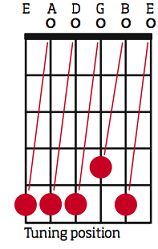How To Tune A Guitar
Before you start playing those first chords or bashing out your first riff, you need to get your axe in tune. Here´s how!

This diagram (right) shows the six strings as they´re laid out on the neck of your guitar, with the thick horizontal line at the top representing the nut. The letters indicate the name/pitch of each string when played open (without your left hand fretting the string to raise the pitch). The first string (on the far right) is the thinnest with the highest pitch, and is called the high E. The second is the B string and so on down to the thickest and lowest pitch string (far left) - the sixth string or low E.
If you have an electronic tuner you now know what pitch each string should be, so you can plug in, tune up and start learning. Alternatively, you can use the ‘5th fret´ approach to tuning which requires you to tune by ear.
Tuning with this method will leave you better equipped in the long run as it will develop your aural skills and prevent you looking stupid when you forget to take your tuner along to a practice or its batteries run out.
The ‘5th fret´ Method
Also known as ‘relative tuning´, this method is the most common way of tuning a guitar yourself. To start off you will need a reference pitch to tune up to. For this you can tune up to another instrument (see 'Other Ways To Tune at bottom of page). Every month, we include a tuning guide on the TG CD, which gives you the pitch of each open string as a reference.
Compare the sound of the low E string (sixth string) on your guitar with the one on the CD. If your note sounds lower you need to tighten the string by turning your machinehead. If your note sounds too high, then you need to use the machinehead to loosen the string and lower the pitch. Letting the string ring after you have played it will allow you to hear its pitch more clearly. [It will take a while before your ear gets used to recognising when a string is out of tune, but you can always cheat and resort back to an electronic tuner...]
Get the MusicRadar Newsletter
Want all the hottest music and gear news, reviews, deals, features and more, direct to your inbox? Sign up here.
Now you have one string in tune, you can use the 5th fret method to tune the remaining strings:
1. Fret the sixth string you have just tuned at the 5th fret - this will raise the pitch of the string to A, the same pitch as the fifth string when played open. By listening to the sound of the low E string with your finger on the 5th fret you can then tune the open fifth string to the same pitch using the machinehead as described above.
2. With the A string in tune, pluck it with your finger on the 5th fret to produce the note D. You can now tune the open fourth string to the pitch of this note.
3. Fret the fourth string at the 5th fret to produce the note G. You can now tune the open third string to the pitch of this note.
4. Fret the third string at the 4th fret this time (the only exception to the 5th fret rule) to produce the note B. You can now tune the open second string to the pitch of this note.
5. Fret the second string at the 5th fret to produce the note E. You can tune the open first string to the pitch of this note.
Other Ways To Tune Up...
An electronic guitar tuner provides a quick and accurate method of tuning, as the meter shows you if each string is in tune. There are other options too…
The pitch pipe [below] has six pipes, each of which correspond to the notes of the open guitar strings - E, A, D, G, B and E.

Use these to tune your strings to the sound of the note you need.
Tuning forks [below] come in different pitches. When an ‘A´ fork is struck it will sound the note that the first (high E) string should produce if pressed down at the 5th fret.

You can also tune the open fifth string to this pitch, but note the pitch of the fork will sound two octaves above the A note you tune your fifth string to.
The diagram below shows you where the notes for each open guitar string can be found on the piano. Hit the key you need and tune the corresponding string up/down to the same pitch.
“I feel like that song had everything we needed to come back with”: Bring Me The Horizon’s Lee Malia on Shadow Moses, its riff and the secrets behind its tone, and why it was the right anthem at the right time
“For those on the hunt for a great quality 12-string electro-acoustic that won’t break the bank, it's a no-brainer”: Martin X Series Remastered D-X2E Brazilian 12-String review









